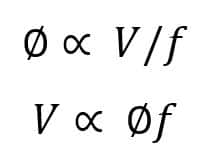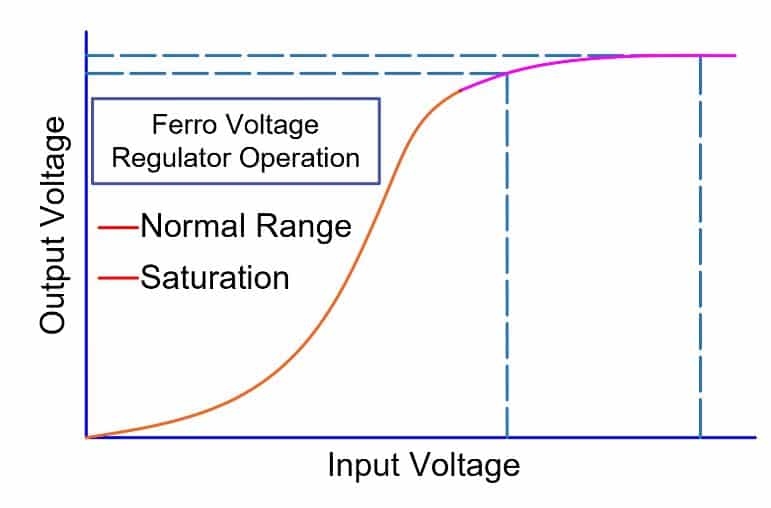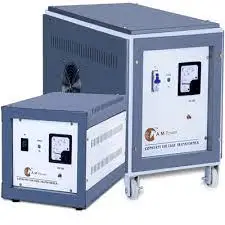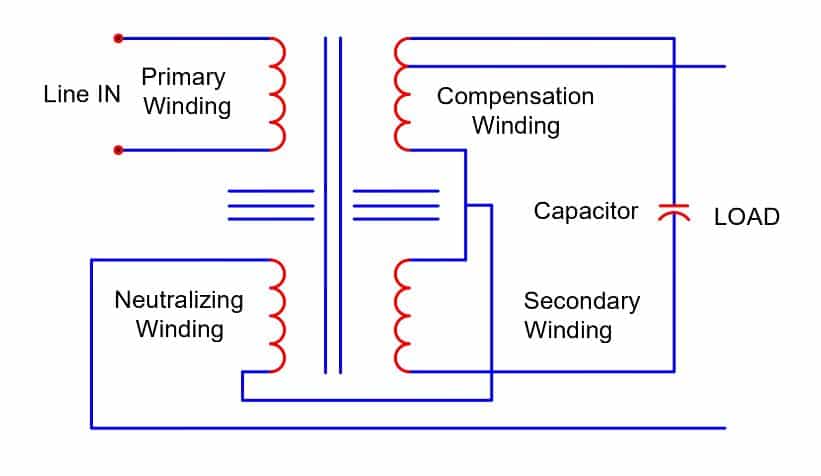Constant Voltage Transformer(CVT) provides a regulated output voltage by ferroresonance phenomenon when there is variation in supply voltage. We also call a CVT Ferroresonant Transformer.
Operating Principle of CVT
In ferroresonance, the magnetic core operates at the magnetic saturation point. On strong magnetization of the core, there is little or no change in the magnetic flux density. Basically, this is the condition of core saturation. Thus, we can say the ferrorsonance limits the flux in the core.
The output voltage of the transformer depends on the frequency and magnitude of the flux through the core. When the transformer core operates in the saturation zone the flux in the core remains more or less constant. The voltage induced in the secondary of the constant voltage transformer is;

From the above equation, it is clear that the secondary voltage is proportional to the flux and the frequency. If frequency remains constant, we can get the constant output voltage if the flux in the core is constant. The flux in the core remains fairly constant if the transformer operates beyond the magnetic saturation point.
Thus, the CVT maintains almost constant even when the input supply varies. In fact, the output voltage of the Ferro varies about 1.2% for every 1% change in supply frequency. Even with a considerable generator frequency change (2-Hertz), there will be an output voltage change of only 4%.
CVT has a turns ratio equal to unity. CVT provides constant output voltage with a variation in the input voltage because it operates on the saturation curve.
This special characteristic of ferroresonant transformers makes it a good choice for a power conditioner.

Constant voltage transformer operates on the principle of core saturation. The magnetic core of CVT has a large amount of magnetic flux of lines for an AC cycle. As a result, the input supply voltage variation does not have a significant effect on the magnetic flux density. And, thus the output voltage fairly remains constant.
Features
The CVT output voltage doesn’t deviate outside of the voltage regulation range (typically 1%-4%), regardless of the input voltage magnitude.
The constant voltage transformer is a passive component, not having a feedback sensing for maintaining the constant output voltage. However, it is possible to use the latest state of electronics technology to improve voltage regulation. We can improve the regulation of CVT by up to 1%.
Applications of CVT
The ferroresonant transformers have widespread application for providing constant voltage. The CVT provides a constant voltage to filaments of oscillators of radio tubes. We also use CVT for providing supply to lighting devices, where constant lux output is desirable.

Mr. Joseph Sola invented the constant voltage transformer in 1938. After its invention. this device underwent minor improvements but fundamentally its design remained the same as its original design.
Working of Constant Voltage Transformer
CVT is a single-phase transformer. However, we can use it in the combination of two or three-phase applications.
When CVT functions on the magnetic saturation point, the output voltage is likely to be non-sinusoidal because of harmonics. The distorted output voltage may cause equipment failure connected to the CVT secondary.

To mitigate the effect of harmonics, the CVT has an auxiliary secondary winding. The capacitor bank has its connection in the parallel of the secondary winding. Thus, the parallel combination of auxiliary winding’s inductance and capacitor banks forms a resonant circuit. It is also called a tuned circuit. The tuned circuit has a tuning frequency equal to the power supply frequency.
This tuned circuit filters the harmonic frequency produced by core saturation, and mitigate the adverse effect of core saturation. Thus we get the sinusoidal output voltage at the main secondary winding of the CVT. The tank circuit also stores the energy in the form of oscillation. The CVT uses this energy in marinating the output voltage in the case of voltage loss up to 1/2 cycle.
Advantages/ Benefits
The CVT provides the following benefits
- Excellent Voltage Regulation – The CVT gives 1% to 4% voltage regulation for input voltage variation ±40% of nominal.
- Sag Mitigation- CVT can maintain the constant output voltage for the voltage sag to 60 % for any duration. However, CVT can not maintain the constant output voltage in the case of deep voltage sag. The CVT is better sag mitigation device than the other devices. The reason of this is CVT is maintenance free, and it does not require batteries.
- Ride-through capability – The tank circuit of the CVT can store the energy for up to 1/2 cycle. We can use the CVT in the combination with an inverter and static transfer switch in a UPS application. In this case, the CVT provides a ride-through capability allowing a completely uninterrupted transfer to an alternate source. Thus, the system maintains the constant output voltage during momentarily supply interruption. This feature is very useful in the event of an overload, fault in the inverter and other faults.
- Current Limiter- We can use CVT for a constant current output application. The CVT brings the current in the specified range by reducing the output voltage. On exceeding current above 150% of rated current, the control unit pull out the unit out of the saturation region. Thus, the output voltage collapses and current settles at the specified rated value. However, we can not use this feature for the equipment drawing high inrush current.
- CVT provides galvanic isolation from surges, transients, harmonics and EMI and RFI noise due to the CVT’s tank circuit design.
- There are no moving parts in the CVT. Thus it is a very robust equipment & provides reliable services.
The constant voltage transformer is the power conditioner used to protect electrical & electronics equipment from power quality problems. We can use the CVT with other power conditioners such as the UPS & TVSS for better results.
Disadvantages of CVT
The CVT has superior voltage regulation because of ferromagnetism. However, ferro efficiency is very much lower than the regular power transformer. At full load and ideal conditions, its efficiency can reach up to only 93% and substantially drops at light load. The efficiency of ferro transformer significantly decreases with a decrease in the loading. The regular transformer has an efficiency of more than 95 %. Whereas, the CVT efficiency ranges from 75% to 85% at half load. It further reduces on reduction of loading on CVT.
We need to oversize the CVT by 2 to 3 times the rated load current for high inrush current. The CVT must permit the large inrush current before output voltage collapses. As a result, the oversizing considerably reduces the efficiency of CVT.
Other disadvantages of CVTs are their large size, humming audible sound, and relatively high cost.
Read Next:
Good work.